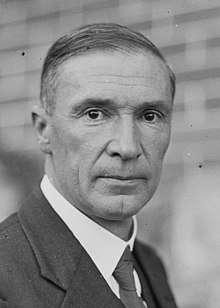Thomas Paterson
Thomas Paterson (20 November 1882 – 24 January 1952) was an Australian politician who served as deputy leader of the Country Party from 1929 to 1937. He held ministerial office in the governments of Stanley Bruce and Joseph Lyons, representing the Division of Gippsland in Victoria from 1922 to 1943. He played a leading role in the creation of the Victorian Country Party as the political arm of the Victorian Farmers' Union.
Thomas Paterson | |
|---|---|
 | |
| Deputy Leader of the Australian Country Party | |
| In office 19 November 1929 – 27 November 1937 | |
| Leader | Earle Page |
| Preceded by | William Gibson |
| Succeeded by | Harold Thorby |
| Minister for the Interior | |
| In office 9 November 1934 – 29 November 1937 | |
| Prime Minister | Joseph Lyons |
| Preceded by | Eric Harrison |
| Succeeded by | John McEwen |
| Minister for Markets and Transport | |
| In office 10 December 1928 – 22 October 1929 Minister for Markets: 19 January 1928 – 10 December 1928 Minister for Markets and Migration: 18 June 1926 – 19 January 1928 | |
| Prime Minister | Stanley Bruce |
| Preceded by | Victor Wilson |
| Succeeded by | Parker Moloney |
| Member of the Australian Parliament for Gippsland | |
| In office 16 December 1922 – 7 July 1943 | |
| Preceded by | George Wise |
| Succeeded by | George Bowden |
| Personal details | |
| Born | 20 November 1882 Aston, Warwickshire, England |
| Died | 24 January 1952 (aged 69) Melbourne, Victoria, Australia |
| Political party | Country |
| Spouse(s) | Elsie Jane Tyrrell ( m. 1908) |
| Occupation | Farmer |
Early life
Paterson was born in Aston, near Birmingham, England and educated at King Edward's School, Birmingham and Ayr Grammar School. He became a shoe salesman in 1897 and later a branch manager, but resigned in 1908 to study farming. In November 1908, he married Elsie Jane Tyrrell and next day set out to Australia with his wife, mother, brother and cousin, where he joined two other brothers on a dairy farm at Springfield, near Romsey, Victoria.[1]
Political career
Paterson joined the Victorian Farmers' Union in 1916, became its president in March 1922 and in November 1922 chaired a conference that led to the creation of the Victorian Country Party. He stood unsuccessfully for the Senate in the 1919 elections and for the Victorian Legislative Assembly in 1920 but in 1922 elections he won the federal seat of Gippsland, defeating the Nationalist George Wise. His victory was one of several Country Party gains that forced the Nationalists to go into Coalition with the Country Party in order to stay in office.
In parliament, he campaigned for a subsidy for dairy exports to be paid for by a tax on Australian consumers and known by opponents as "Paterson's Curse" (referring to the Australian name for Echium plantagineum). £20 million were paid under this scheme between 1926 and 1933. Paterson was Minister for Markets and Migration from June 1926 to January 1928, Minister for Markets from January to December 1928 and Minister for Markets and Transport from December 1928 to October 1929. He was deputy leader of the parliamentary Country Party from 1929 to 1937, under Earle Page, and was acting leader for several months in 1933 following the death of Page's son.
He was appointed Minister for the Interior in the Lyons coalition government in November 1934. Also in November 1934 he made an exclusion order against Czech writer Egon Kisch which was later overturned by the High Court. He resigned as minister and deputy party leader after the 1937 elections, as a result of the 1936 controversy over the exclusion from Australia of Mabel Freer, a white British woman born in India, who, under the terms of the 1901 Immigration Restriction Act, had failed a dictation test in Italian.[2]
During his time as Minister for the Interior, Paterson was praised by William Cooper of the Australian Aborigines' League for his goodwill and support of the League's requests for greater government assistance to Aboriginal people.[3]
Paterson remained prominent in Country Party affairs and helped form a breakaway party from the Victorian Country Party that was loyal to the federal parliamentary Country Party in March 1938. He helped reconcile the federal and Victorian parties in 1943, but did not stand for re-election in 1943 elections. He died of coronary vascular disease at his Melbourne home, survived by his wife and elder son.[1]
References
- Costar, B. J. (1996). "Paterson, Thomas (1882–1952)". Australian Dictionary of Biography. Melbourne University Press. ISSN 1833-7538. Retrieved 3 November 2007 – via National Centre of Biography, Australian National University.
- Robertson, Kel (2005). "Dictating to One of 'Us': the Migration of Mrs Freer". Macquarie Law Journal. Australasian Legal Information Institute. Retrieved 26 April 2017.
- Attwood & Markus, pp. 95-96.
Sources
- Attwood and Markus (2004) Thinking Black: William Cooper and the Aborigines' Advancement League, Aboriginal Studies Press: Canberra. ISBN 0 85575 459 1.
| Political offices | ||
|---|---|---|
| Preceded by Victor Wilson |
Minister for Markets and Migration Minister for Markets Minister for Markets and Transport 1928–29 |
Succeeded by Parker Moloney |
| Preceded by Eric Harrison |
Minister for the Interior 1934–37 |
Succeeded by John McEwen |
| Parliament of Australia | ||
| Preceded by George Wise |
Member for Gippsland 1922–43 |
Succeeded by George Bowden |
| Party political offices | ||
| Preceded by William Gibson |
Deputy Leader of the Country Party of Australia 1929–37 |
Succeeded by Harold Thorby |